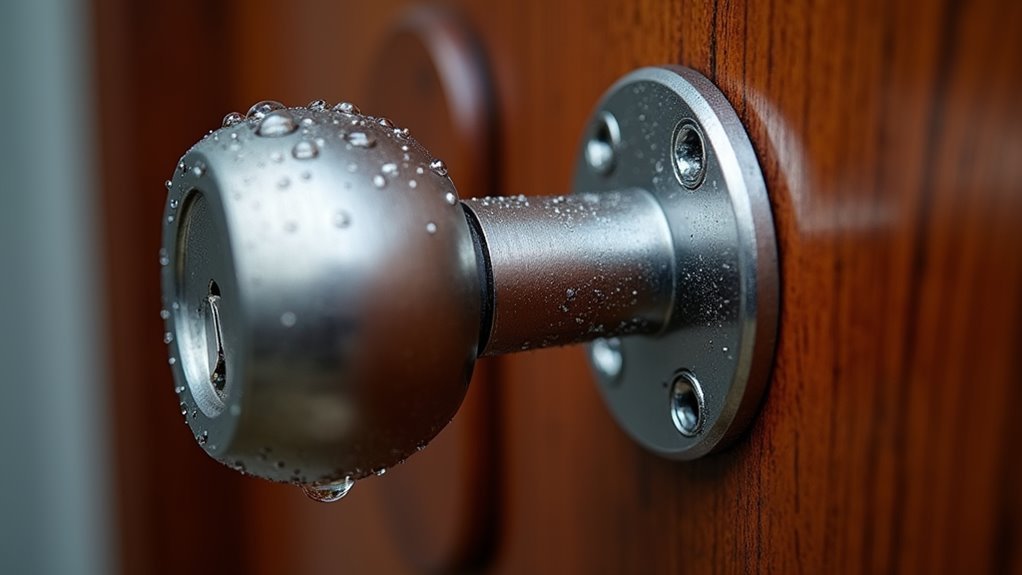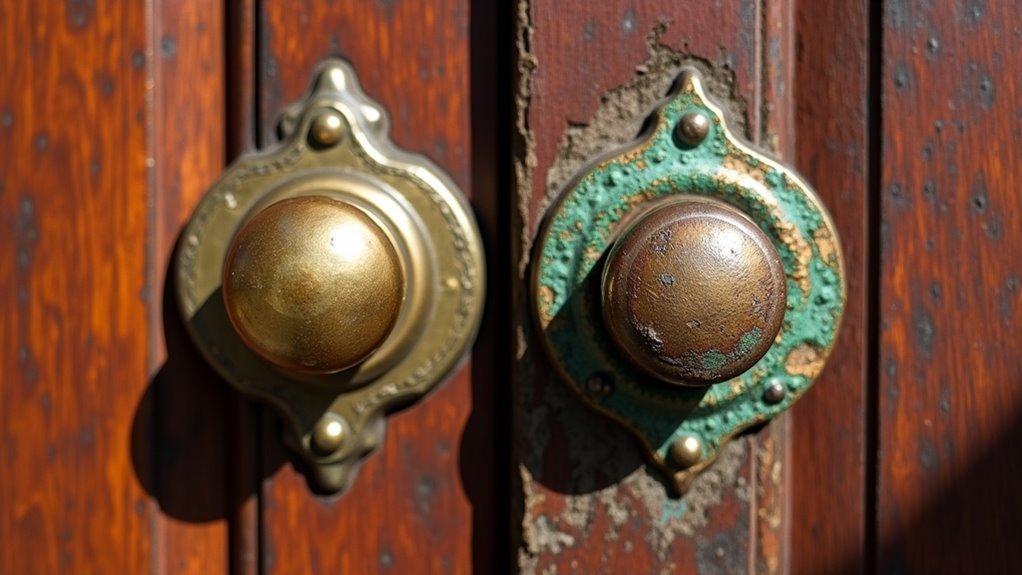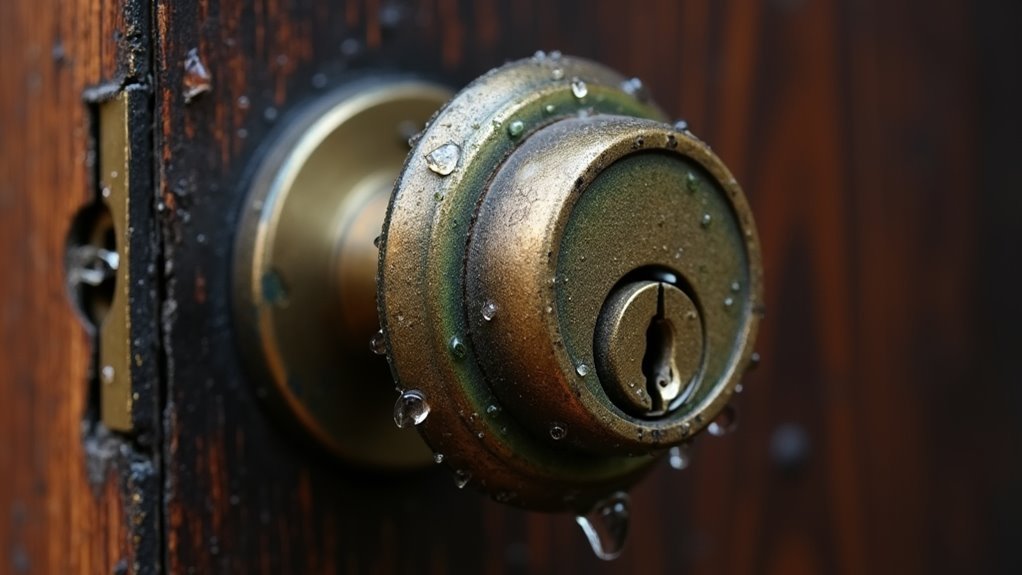You’ve probably experienced the frustration of a door lock that’s seized up after a storm or refusing to turn during winter weather. Your home’s security shouldn’t depend on favorable conditions, yet many homeowners overlook the critical steps needed to protect their locks from nature’s elements. While standard locks might work fine indoors, outdoor exposure demands specific strategies that most people don’t consider until it’s too late.
Choose Locks With Weather-Resistant Materials

When selecting weatherproof door locks, you’ll want to prioritize materials that can withstand your local climate conditions.
Stainless steel stands out as the top choice for a weather-resistant lock, especially in high humidity or saltwater environments where corrosion poses a significant threat. Its exceptional durability makes it ideal for harsh conditions.
Stainless steel delivers unmatched corrosion resistance, making it the premier choice for locks exposed to humidity and saltwater conditions.
Brass offers another excellent option among weather-resistant materials, combining traditional aesthetics with reliable rust resistance across various weather environments.
For budget-conscious buyers, zinc alloy locks provide cost-effective corrosion protection when properly finished.
Don’t overlook the importance of high-quality finishes like satin nickel or powder coating, which enhance moisture and UV protection.
Remember that quality weather-resistant locks undergo rigorous testing to guarantee they’ll maintain functionality and security despite temperature fluctuations and environmental challenges.
Apply Regular Lubrication and Cleaning Maintenance
You’ll need to establish a consistent maintenance routine that focuses on proper lubrication and thorough cleaning to keep your weatherproof locks functioning effectively.
Select the right lubricants for your specific lock type and environmental conditions, then create a seasonal cleaning schedule that addresses debris removal and corrosion prevention.
Consider whether you can handle all maintenance tasks yourself or if certain aspects require professional service to guarantee your locks maintain their weather resistance and security features.
Choose Proper Lubricants
Since your weatherproof door lock’s performance depends heavily on proper lubrication, selecting the right products makes all the difference in maintaining smooth operation year-round.
Choose proper lubricants specifically designed for outdoor use rather than standard household products. Silicon-based and graphite lubricants offer superior protection against moisture and extreme temperatures that weatherproof door locks regularly face.
These specialized formulations resist environmental stressors better than conventional lubricants, preventing breakdown when exposed to rain, snow, or coastal salt air. They won’t attract dirt and debris like oil-based alternatives, keeping your lock mechanisms cleaner longer.
Quality outdoor lubricants also maintain their protective properties across temperature fluctuations, ensuring consistent performance. This targeted approach to maintenance extends your lock’s lifespan while reducing replacement costs and preventing unexpected failures during harsh weather conditions.
Seasonal Cleaning Schedule
Establishing a consistent seasonal cleaning schedule prevents weatherproof door locks from accumulating damaging debris and maintains their security performance throughout the year.
You should conduct thorough cleaning every season, removing dirt that can hinder operation. Locks must receive silicon-based or graphite lubricant at least annually to prevent rust and guarantee smooth functioning.
During winter months, check for freezing or stiffness, using de-icing products when necessary.
In coastal areas, increase your maintenance frequency to quarterly since salt buildup accelerates corrosion.
Extreme weather conditions require more vigilant care, especially for smart locks with electronic components.
After each cleaning session, test every lock mechanism to detect stiffness or resistance, enabling timely repairs before issues compromise security.
Professional Maintenance Service
While maintaining weatherproof door locks yourself provides essential ongoing care, professional maintenance services offer specialized expertise that guarantees extensive protection against environmental damage.
A professional locksmith can perform detailed inspections that identify potential issues you might miss, making certain your weatherproof locks continue protecting your home security effectively.
These maintenance services include detailed adjustments to internal mechanisms, specialized lubrication techniques, and thorough cleaning of all components.
Professional technicians understand how environmental stressors affect different lock types and can recommend specific preventive measures for your climate conditions.
Regular professional maintenance extends your locks’ lifespan while maintaining peak security features.
Expert services make sure that small problems don’t escalate into major failures, keeping your weatherproof locks functioning smoothly year-round and providing reliable protection for your property.
Install Protective Covers and Weatherproof Seals
Although your weatherproof door lock may feature robust construction, you’ll need additional protection to shield it from harsh environmental conditions. Installing protective covers creates a barrier against rain, snow, and debris, greatly reducing moisture-related damage risks. These covers work alongside weatherproof seals to prevent water and dust penetration.
| Protection Type | Primary Benefit |
|---|---|
| Protective Covers | Shield from direct weather exposure |
| Weatherproof Seals | Prevent water/dust penetration |
| Sealed Mechanisms | Built-in weather resistance |
| Coastal Protection | Prevent salt-induced corrosion |
High-quality seals prevent rust and corrosion, especially in coastal areas where salt exposure threatens metal components. You’ll want to check and replace worn covers regularly to maintain effectiveness. Selecting locks with built-in protective features enhances resistance to weather-related wear and tear.
Select Appropriate Lock Finishes for Your Climate

Since climate conditions vary dramatically across different regions, you’ll need to choose lock finishes that can withstand your specific environmental challenges.
Satin nickel provides excellent scratch resistance and prevents tarnish, making it perfect for areas with high humidity exposure. Polished chrome offers superior moisture resistance but shows fingerprints easily, so it’s better for cleaner environments.
For extreme weather conditions, powder-coated finishes deliver exceptional durability and scratch protection, ideal for outdoor installations. If you live in sunny climates, select UV-resistant finishes to prevent discoloration and fading.
Match your finish to the lock’s base material—stainless steel or brass—to maximize corrosion resistance. These durable locks will maintain both functionality and appearance regardless of environmental stressors.
Position Locks Away From Direct Weather Exposure
Choosing the right finish protects your lock’s surface, but strategic placement shields the entire mechanism from weather damage. When you position locks thoughtfully, you’ll safeguard internal parts from moisture, freezing, and corrosion that cause malfunctions.
Strategic lock placement creates natural barriers against moisture, freezing, and corrosion that compromise internal mechanisms and cause costly malfunctions.
Here’s how to optimize your lock placement:
- Install under overhangs – Position locks beneath awnings or roof extensions to block direct rain, snow, and UV exposure.
- Use recessed mounting – Place locks within door frame indentations to create natural weather barriers against harsh weather conditions.
- Apply weatherproof seals – Install protective sealing around the lock area to prevent moisture infiltration into sensitive mechanisms.
- Maintain clear access – Keep debris and snow away from locks to prevent misalignment during extreme weather conditions.
Regular positioning inspections help you identify vulnerabilities before they compromise your lock’s performance.
Monitor and Address Early Signs of Weather Damage

Even with ideal positioning and quality finishes, weather conditions will eventually impact your lock’s performance if you don’t monitor for early warning signs.
Regular inspection helps you catch corrosion before it compromises security. Check for rust, especially in coastal areas where salt accelerates weather damage to locks.
Watch for sticky or misaligned mechanisms that indicate moisture infiltration or temperature-related expansion.
Clean your locks periodically to remove dirt and debris that accumulate in harsh conditions. Annual maintenance should include lubricating moving parts with silicone-based or graphite products to prevent freezing.
Address operational stiffness immediately—it’s often the first sign of internal damage.
Don’t wait until locks fail completely. Prompt attention to these early indicators guarantees your weatherproof locks maintain their protective function and longevity.
Upgrade to Marine-Grade Components for Harsh Environments
When standard weatherproofing measures aren’t enough for your coastal property or extreme climate zone, marine-grade door locks provide the ultimate defense against environmental assault.
These specialized marine-grade components excel in harsh environmental conditions where regular locks fail.
You’ll benefit from superior corrosion resistance through these key features:
- Stainless steel construction – eliminates rust formation in salty, humid environments
- Plastic-free design – prevents degradation from UV exposure and temperature extremes
- Rigorous testing standards – guarantees reliable security performance in extreme weather
- Reduced maintenance requirements – extends operational lifespan considerably
The enhanced durability of marine-grade locks means you won’t constantly replace corroded components.
While they cost more upfront, you’ll save money long-term through improved security and reduced replacement needs in challenging coastal climates.
Frequently Asked Questions
What Is the Best Lubricant for Outdoor Locks?
You’ll want silicone-based lubricants for outdoor locks since they repel moisture and prevent rust while working in extreme temperatures. Graphite powder’s another excellent choice that won’t attract dirt or debris.
Should You Put WD-40 in a Lock?
You shouldn’t put WD-40 in a lock because it attracts dust and debris, potentially causing more problems. Use graphite or silicone-based lubricants instead for better lock performance and longevity.
What Door Locks Do Police Recommend?
You should install Grade 1 deadbolts that withstand 800,000 cycles and multi-point locking systems. Police recommend smart locks with biometric access, stainless steel construction for durability, and compliance with local building codes.
How Do I Keep My Outdoor Locks From Rusting?
You’ll prevent outdoor lock rusting by choosing stainless steel or brass materials, applying annual silicon-based lubricant, cleaning regularly to remove debris, and installing weatherproof covers for protection.





Leave a Reply